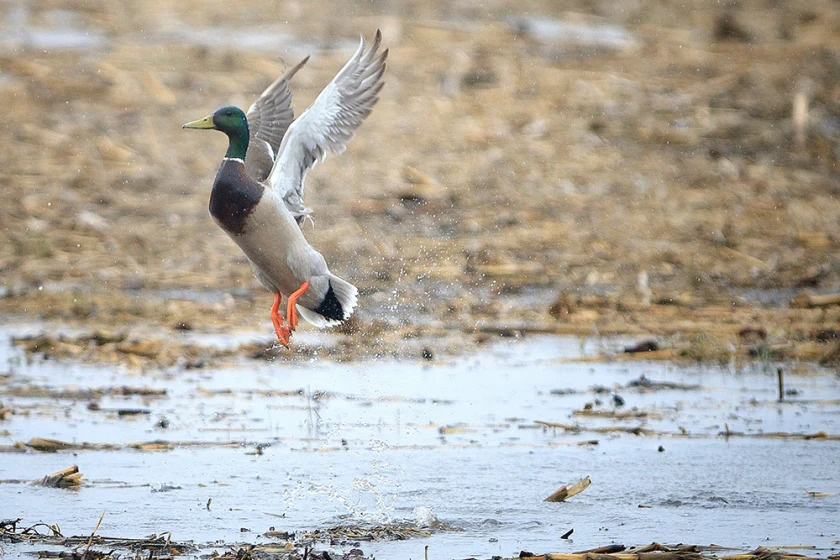Continental duck numbers are similar to 2024 but down from long-term averages since 1955, the U.S. Fish and Wildlife Service said Tuesday, Sept. 2, in reporting results from its 2025 Waterfowl Population Status Report. The report includes results from surveys and population estimates conducted in May by the FWS, Canadian Wildlife Service and numerous state and provincial partners.
The estimate for total breeding ducks in the traditional survey area was 34 million, unchanged from last year, but 4% below the long-term average since 1955, the FWS said in the report. Mallards, at 6.6 million, were similar to 2024 and 17% below the long-term average.
“Waterfowl again demonstrated their adaptability to changing water conditions despite overall dry conditions in 2024, as late-nesting species capitalized on spring rains in the prairies and those that settled in the Boreal (forest) held their own,” Steve Adair, Ducks Unlimited chief scientist, said in a statement. “These flexible breeding strategies and use of continental habitat resources in 2024 appear to have contributed to decent production last year, which carried over to a similar breeding population this spring.”
Pintails were estimated at 2.2 million, 13% above 2024, but 41% below the long-term average. As a result of a change in federal harvest models, hunters in all four flyways — Pacific, Central, Mississippi and Atlantic — are expected to have a three-pintail daily bag limit option for next year’s 2026-2027 season, based on this year’s breeding population results.
Cause for concern
The survey results released Sept. 2 also reflected generally dry spring breeding conditions. According to the FWS, the 2025 May pond estimate was 4.2 million, a 19% decrease from the 2024 estimate of 5.2 million and 20% below the long-term average.
That’s cause for concern, Delta Waterfowl said in a news release.
“Duck production is not likely to be good this year,” Frank Rohwer, president and chief scientist of Delta Waterfowl, said in a statement. “When you look at the wetland conditions maps from May, they show it was very dry everywhere across the Prairie Pothole Region except eastern South Dakota. The best hunting seasons occur in wet years when the fall flight has more young ducks in the migration.”
Spring wetland conditions in North Dakota also were poor before “nourishing rains” in May, the Game and Fish Department reported in June. That likely caused early migrating species such as mallards and pintails to pass through North Dakota in search of better water conditions farther north. North Dakota’s breeding duck index, at about 2.66 million, was down from 2.9 million in 2024 and 3.4 million in 2023, Game and Fish said.
In Minnesota, the Department of Natural Resources in August reported that total breeding ducks (excluding scaup), at 417,000, were up 8% from 2024 but 32% below the long-term average. The DNR estimated blue-winged teal numbers at 64,000, down 60% from 2024 and 69% below the long-term average. The decline likely results from dry conditions and fewer of the small, temporary wetlands that blue-winged teal prefer for breeding, the DNR said.
Duck production across the prairies is likely to be fair to poor, despite May rains, Delta Waterfowl predicts.
“The May rains likely helped support a moderate number of nesting ducks,” Mike Buxton, waterfowl programs director for Delta Waterfowl, said in a statement. “However, much of the precipitation in North Dakota and Saskatchewan arrived too late, and the gains were short-lived as heat, wind and a lack of more rain dried up wetlands in June. Localized areas of Alberta received rain in June, and they stood out as rare bright spots.”
The prairies now have faced several consecutive years of drought, among the longest stretches in recent memory, Ducks Unlimited said.
“Although May rains provided some relief to extremely dry winter conditions, the cumulative effects of widespread and long-term drought in the prairies are apparent, as parched soils soak up available moisture and more and more wetlands continue to dry out,” DU’s Adair said. “There are long-term benefits of recycling nutrients and exposure of seed banks, but droughts are painful when they’re happening.”
Other highlights
Ducks Unlimited also highlighted several key takeaways from the survey:
— According to the companion Adaptive Harvest Management (AHM) report, the FWS is expected to recommend liberal frameworks for the 2026-2027 duck season across all four flyways.
— Blue-winged teal estimates in the traditional survey area were 4.4 million, a 4% decrease from 2024, which is expected to keep hunters in the Central, Mississippi and Atlantic flyways at a nine-day early teal season for 2026–2027.
— The Boreal Forest and other northern survey areas saw generally drier, but variable, habitat conditions. An early spring coupled with prairie drought resulted in another year of an above-average number of breeding ducks settling in the Boreal.
Related Articles
St. Paul’s 10th Annual Walk for Water to support clean water in Kenya
A unique spirit is causing a buzz among drinkers — literally
The 140th St. Paul Winter Carnival is less than 140 days away. Here’s what to know.
Scandia’s Taco Daze festival marks 50th anniversary this weekend
‘Unholy Communion,’ a murder mystery shot in St. Paul, is coming to home screens
— Canvasbacks (up 22%) and redheads (up 17%) saw notable increases from 2024.
— Duck populations in the eastern survey area remained healthy, reflecting overall stable wetland conditions. Atlantic Flyway hunters are expected to have another four-mallard daily bag limit for the 2026-2027 season.
The Waterfowl Breeding Population and Habitat Survey and the Waterfowl Status Report are the result of a collaborative effort conducted annually by the FWS, Canadian Wildlife Service and the Atlantic, Mississippi, Central and Pacific flyway councils.


Leave a Reply